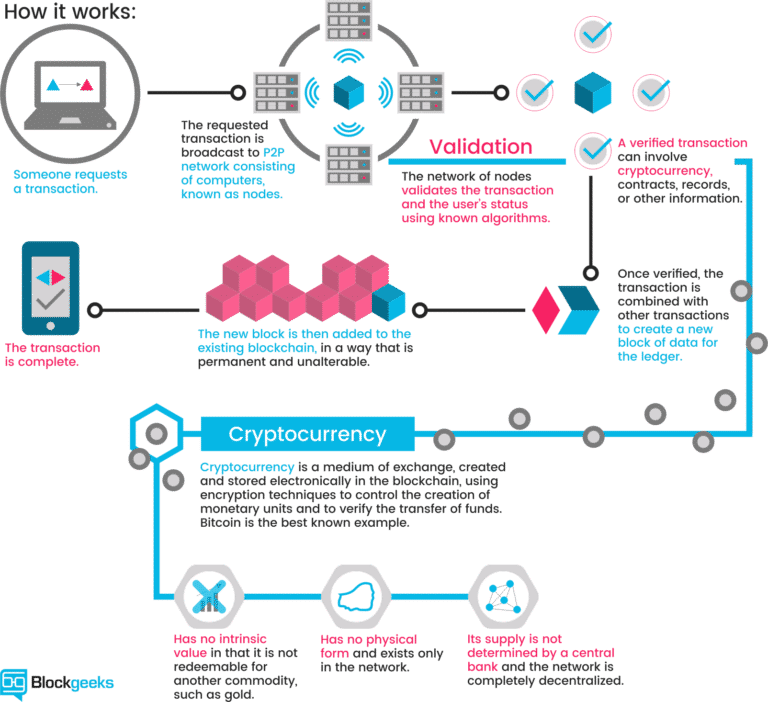If you’re interested in technology, you’ve probably heard of cryptocurrencies – or of Bitcoin, at least. But what you might be less aware of is the growing market for cryptocurrencies in video games.
Cryptocurrencies find their place in games in a variety of ways. One way is the play-for-pay model, in which players are rewarded with small amounts of cryptocurrency for playing the game.
Other ways include projects like Game Credits, which create their own cryptocurrency that can be transferred and used across a network of games.
But before we go too deeply into cryptocurrencies and their relationship with games, what are cryptocurrencies exactly?
Explainer: Cryptocurrency

Image source: blockgeeks.com
For a much more in-depth explainer, head over to blockgeeks.com who created this infographic. But, we can start with the broad terms.
Essentially, cryptocurrencies are digital currencies that are stored, regulated and produced by mathematics (cryptography), rather than by banks, governments or physical resources.
More specifically, Bitcoin – the most prominent and popular cryptocurrency – is based on the SHA 256 Hash algorithm. Because Bitcoin’s algorithm is open source, thousands of other cryptocurrencies have been created based on the same foundation.
Creating Bitcoins comes about through a process termed ‘mining’, and is a key part of how Bitcoin is decentralised and self-regulating. To mine Bitcoins, the SHA 256 Hash algorithm generates cryptographic puzzles which your computer then solves. Each solved puzzle adds a block to the blockchain, and you are rewarded with an amount of Bitcoins. This reward started at 50 BTC (Bitcoins), but for every 210,000 blocks mined the reward halves. That’s roughly every four years. What this does is ensures that the total amount of Bitcoins will never exceed 21 million.
The blockchain is essentially the ledger – it records and verifies each transaction in chronological order. This means that, in theory, no transaction can be forged or double-spent. Mining is what keeps Bitcoin working and secure.
However, in addition to that, the difficulty of each puzzle scales with the total speed of the network (the amount of people mining and their combined computational power). This is called the hashrate, and serves to decentralise the network.
By decentralising it, it also becomes near-impossible to ‘hack’ the network. The details are complex, but essentially, if someone controls over half of the hashrate (i.e., they have over 50% of the computational power contributing to the network) then they can double-spend their money, forge transactions, and all kinds of potentially quite devastating mischief.
What this also means is a computational arms race. While originally designed to use CPUs, most miners now use GPUs or specialised chips, both of which (the latter more than the former) can be programmed to specialise in mining. Unfortunately for gamers, this is probably why you’re finding some graphics cards rocketing up in price.
Every user has a Bitcoin wallet. This has a public and a private key. The private key is used for accessing it and using the funds, while the public key is so that other vendors and traders know which wallet is yours.
Bitcoin and other cryptocurrencies are valued for many reasons. Yes, people like them because they are anonymous and harder to trace and are therefore useful for all kinds of illegal activities from money laundering to buying illicit weapons and drugs. Mining also consumes a hell of a lot of power.
But Bitcoin is also arguably more secure than physical currencies, more resilient to fraud. You can’t simply have your credit card cloned, for instance, or your computer hacked and your bank details stolen.
It’s also safe from the jurisdiction of central governments. While this doesn’t concern most people, for some it’s a deal breaker. Furthermore, it doesn’t inflate like regular currencies, due to the 21 million BTC ceiling.
So, what does this mean for the rest of us non-miners? (Apart from our graphics cards becoming more expensive.)
Well, as mentioned at the beginning, games and other services are increasingly buying into the world of cryptocurrencies in various ways. Live casino games such as blackjack and electronics vendors like NewEgg as well as many more now allow you to play and purchase using Bitcoin.
We’re also starting to see games like Beyond the Void implementing blockchain currency as their in-game currency. This could be hugely useful for MMORPGs and other multiplayer games with marketplaces. At present, in-game currency tends to be messy. In many games it’s practically worthless, while in others highly volatile and requiring convoluted gold sinks to keep the economy working. Blockchain currency has inherent value, and so could be a useful remedy.
Exciting new projects like Game Credits also take this principle, but apply that currency across a particular network of games. So the money you make in one game can help give you a head start in another.
But these applications are all in their infancy yet. So far, despite both being tech-related, cryptocurrencies and video games haven’t had too much to do with each other. Apart from the fact that each community is probably interested in the other.
The potential applications, though, are exciting, as we’ve seen from some of the burgeoning projects coming forward with different applications of cryptocurrencies in games, both in the gameworld and outside of it.
Perhaps video games can give cryptocurrencies the final push to becoming truly mainstream.

